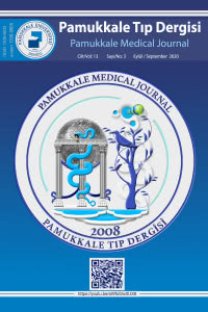Recurrent painless lump on lower lip in a girl; mucocele
A 10-year-old girl was admitted to pediatric rheumatology department due to recurrent painless lump on her lower lip. Her past medical history revealed that she had the lesions began within the last 4 months. The mother stated that these lesions started after her younger brother was born 4 months ago. She presented with the same complaint at another medical center 2 months prior, and she was diagnosed with stomatitis related to deficiencies of vitamins and zinc. Despite oral multi-vitamin and zinc supplementation, local steroid and anti-mycotic treatments, the lesions did not improve. Oral examination revealed there was a transparent liquid-filled lump around slightly hyperemic with the size 6x3 mm on the lower lip mucosa. On the right side there was a shrunken lump (Figure). The lower lip was dry. The other organ systems, growth and development parameters were normal. Regarding this typical image, the lesion on the lip of the patient was diagnosed mucocele which is cystic lesion of minor salivary glands on oral mucosa. Mucoceles are typically transparent or bluish, recurrent submucosal painless masses, and more frequent on lower lip. The most important cause of mucocele is habit of lip or cheek biting due to stress that can lead trauma and the saliva leaks from the damaged duct into the adjacent connective tissue (1). Herpes simplex labialis, exposure to an allergen should be considered in differential diagnosis. Herpes simplex labialis lesions which are caused by human herpes simplex virus are small blisters. The lesions are typically vesicular and recurrent. They usually occur around the mouth, lips, or nose. Before the appearance of herpes labialis; focal pain, burning, itching, or tingling may be observed in the affected area. The vesicles tend to merge, rupture, and then crust quickly in a few days. Herpes labialis improves completely within two weeks (2). Exposure to an allergen can cause lip inflammation followed by a lump. Allergens that can trigger a reaction on the lips include lipstick products (especially in preadolescents and adolescents), foods such as chocolate and strawberry (in younger children), and pet dandruff. Children with this type of reaction may often experience recurrent lip swelling and itchy lumps after exposure to the allergen. The clinical findings and medical history of the patient were not compatible with any of the above. When the anamnesis was detailed, it was understood that she showed beginning jealous behavior associated with birth of his brother 4 months ago. After birth of his brother, she has showed low academic performance in school compared to last year and a habit of lip biting has begun. Her mucocele excised surgically, and a child psychiatrist has been consulted. It is widely accepted that surgical excision and cryosurgery are effective treatments for childhood mucoceles (1).
Recurrent painless lump on lower lip in a girl; mucocele
A 10-year-old girl was admitted to pediatric rheumatology department due to recurrent painless lump on her lower lip. Her past medical history revealed that she had the lesions began within the last 4 months. The mother stated that these lesions started after her younger brother was born 4 months ago. She presented with the same complaint at another medical center 2 months prior, and she was diagnosed with stomatitis related to deficiencies of vitamins and zinc. Despite oral multi-vitamin and zinc supplementation, local steroid and anti-mycotic treatments, the lesions did not improve. Oral examination revealed there was a transparent liquid-filled lump around slightly hyperemic with the size 6x3 mm on the lower lip mucosa. On the right side there was a shrunken lump (Figure). The lower lip was dry. The other organ systems, growth and development parameters were normal. Regarding this typical image, the lesion on the lip of the patient was diagnosed mucocele which is cystic lesion of minor salivary glands on oral mucosa. Mucoceles are typically transparent or bluish, recurrent submucosal painless masses, and more frequent on lower lip. The most important cause of mucocele is habit of lip or cheek biting due to stress that can lead trauma and the saliva leaks from the damaged duct into the adjacent connective tissue (1). Herpes simplex labialis, exposure to an allergen should be considered in differential diagnosis. Herpes simplex labialis lesions which are caused by human herpes simplex virus are small blisters. The lesions are typically vesicular and recurrent. They usually occur around the mouth, lips, or nose. Before the appearance of herpes labialis; focal pain, burning, itching, or tingling may be observed in the affected area. The vesicles tend to merge, rupture, and then crust quickly in a few days. Herpes labialis improves completely within two weeks (2). Exposure to an allergen can cause lip inflammation followed by a lump. Allergens that can trigger a reaction on the lips include lipstick products (especially in preadolescents and adolescents), foods such as chocolate and strawberry (in younger children), and pet dandruff. Children with this type of reaction may often experience recurrent lip swelling and itchy lumps after exposure to the allergen. The clinical findings and medical history of the patient were not compatible with any of the above. When the anamnesis was detailed, it was understood that she showed beginning jealous behavior associated with birth of his brother 4 months ago. After birth of his brother, she has showed low academic performance in school compared to last year and a habit of lip biting has begun. Her mucocele excised surgically, and a child psychiatrist has been consulted. It is widely accepted that surgical excision and cryosurgery are effective treatments for childhood mucoceles (1).
___
- 1. Bodner L, Manor E, Joshua BZ, Shaco-Levy R. Oral Mucoceles in Children--Analysis of 56 New Cases. Pediatr Dermatol. 2015;32(5):647-650. https://doi.org/10.1111/pde.12535
- 2. Ahluwalia J, Han A, Kusari A, Eichenfield LF. Recurrent herpes labialis in the pediatric population: Prevalence, therapeutic studies, and associated complications. Pediatr Dermatol. 2019;36(6):808-814. https://doi.org/10.1111/pde.13978
